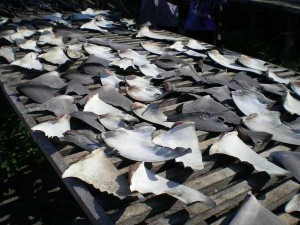What Scientists Are Learning About Sharks in the Gulf

Photo by flickr user USFWS Headquarters
Scientists in the Gulf are conducting groundbreaking research on shark behavior.
It’s early August, and that means that this week millions of Americans are watching one of TV’s greatest aquatic traditions: Shark Week on the Discovery Channel.
Texans, whose state borders a body of water teeming with sharks of all sizes and species may want to take special notice. According to Dr. Greg Stunz, there are some sizable specimens in the Gulf of Mexico.
“Big ones,” he said in describing some of the Gulf’s sharks. “9-feet, 600-pound kind of [sharks]. ‘They-could-easily-eat-people’ kind of size.”
Dr. Stunz is a Professor of Marine Biology and an Endowed Chair for Fisheries and Ocean Health at Texas A&M University – Corpus Christi’s Harte Research Institute. He’s currently researching shark behavior and population trends off the Padre Island National Seashore.
Stunz is one of the first scientists to gather data on shark growth and movement in the Gulf. He and his team have tagged over one thousand sharks in order to better understand which species are most common, where they occur, and how often they breed.
“We don’t have answers to those questions,” Stunz said.
Consequently, Stunz’s work has produced some important findings – notably that climate change hasn’t really affected sharks in the Gulf.
“Along the Texas coast, we haven’t experienced a lot of climate change on the scale that would affect shark distribution patterns,” Stunz said. “[Sharks] are typically highly migratory, so they’re moving in response to temperatures on an annual basis that’s independent of long-term trends.”
One shark that Stunz tagged covered over 600 miles in just a few months, swimming from Corpus Christi to Houston and then back down to Mexico.
View Gulf Coast Shark Map in a larger map
But their resilience to climate change doesn’t mean that sharks are immune to human influence.
Sharks, especially big ones, are being overfished around the world, and the Gulf is no exception. Though it is legal in Texas to catch and eat certain species of sharks, illegal finning is causing real damage to the populations of certain species.

Photo by flickr user blamethepeople
Shark finning is illegal, but still kills thousands of sharks per year.
Finning refers to the practice of removing a shark’s fins then leaving the creature in the ocean to die. Those fins are then sold at a premium for shark fin soup or medicinal purposes. Thousands of sharks can be finned in a single excursion.
“It’s wholesale slaughter,” Stunz said, noting that most of the finning that occurs in the Gulf is perpetrated by Mexican fishermen using illegal gill nets.
H.B. 852, a bill that would have outlawed the fin trade in Texas, died on the Senate floor during the most recent legislative session. Although lawmakers supported the bill’s principles, there was confusion about the bill’s language and how it would be enforced.
“It wasn’t constructed as well as it should have been. I would suspect in the future you’ll see a strengthening of that legislation. Everyone supported it conceptually,” Stunz said.
But that will have to wait until 2015 at the earliest, when the next legislature convenes. Until then, Stunz and his team will continue their research, hoping that their findings might help shift population trends.
“We don’t really know what [populations] looked like many years ago in terms of real, true, abundance,” he said. “But there’s consensus that there was a lot more than there we have today.”